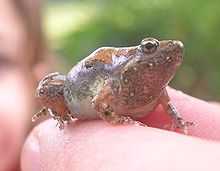Microhyla ornata
| Ornate narrow-mouthed frog | |
|---|---|
 | |
| Conservation status | |
| Scientific classification | |
| Kingdom: | Animalia |
| Phylum: | Chordata |
| Subphylum: | Vertebrata |
| Class: | Amphibia |
| Order: | Anura |
| Family: | Microhylidae |
| Genus: | Microhyla |
| Species: | M. ornata |
| Binomial name | |
| Microhyla ornata (Duméril and Bibron, 1841)[2] | |
The ornate narrow-mouthed frog or ornamented pygmy frog (Microhyla ornata) is a species of microhylid frog found in South Asia. This amphibian is distributed in Kashmir, Nepal, peninsular India and the Andaman and Nicobar Islands, Sri Lanka, and Bangladesh.[3]
Description

Frogs of the genus Microhyla are small. They can be identified by the typical arrow-shaped mark on their dorsal side. They are generally of yellowish color with dark brown patch. This species has a small head, no teeth and no discernible tympani. The fingertips are spathulate and there is little webbing between the digits. The males do not have nuptial pads. The skin on the back is mainly smooth but there are some granulations. Males are about 24 mm (0.9 in) from snout to vent and females about 28 mm (1.1 in).[4]
Distribution and habitat
The ornate narrow-mouthed frog is native to Bangladesh, Bhutan, India, Nepal, Pakistan and Sri Lanka. It is found in grass and leaf litter in habitats ranging from tropical and subtropical grasslands, savannas, and shrublands to tropical and subtropical moist broadleaf forests, tropical and subtropical dry broadleaf forests and tropical and subtropical coniferous forests.[1]
In some habitats, this frog may take shelter in the dung of elephants.[5]
Biology
The ornate narrow-mouthed frog lives semi-buried in leaf litter on the forest floor. It is mainly nocturnal but it is also active during the day during the rainy season. It breeds in ponds and temporary pools that form in the rainy season.[1]
Status
This frog has a wide range and the population seems to be stable so the IUCN rates it as being of "Least Concern" as it considers that the rate of decline, if any, is insufficient to justify listing it in a more threatened category. It is common throughout most of its range and is tolerant of a range of different habitat types. No particular threats to this species have been identified.[1]
References
- ↑ 1.0 1.1 1.2 1.3 Sushil Dutta, Tej Kumar Shrestha, Kelum Manamendra-Arachchi, Muhammad Sharif Khan, Debjani Roy (2004). "Microhyla ornata". IUCN Red List of Threatened Species. Version 2012.2. International Union for Conservation of Nature. Retrieved 2013-06-11.
- ↑ Duméril, A. H. and G. Bibron, 1841. Erpetologie generale ou Histoire Naturelle complete des reptiles. Vol. 8. , Paris.
- ↑ Frost, Darrel R. (2013). "Microhyla ornata (Duméril and Bibron, 1841)". Amphibian Species of the World 5.6, an Online Reference. American Museum of Natural History. Retrieved 2013-06-11.
- ↑ Ambika Sopory (2002-05-28). "Microhyla ornata". AmphibiaWeb. Retrieved 2013-12-10.
- ↑ Campos-Arceiz, A (2009). "Shit Happens (to be Useful)! Use of Elephant Dung as Habitat by Amphibians". Biotropica 41 (4): 406–407. doi:10.1111/j.1744-7429.2009.00525.x.
